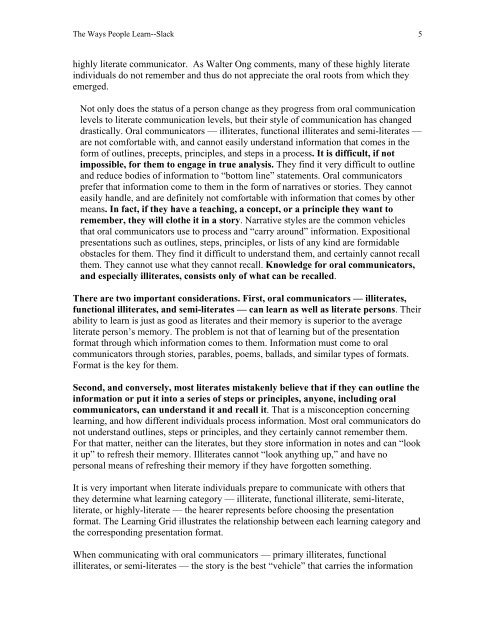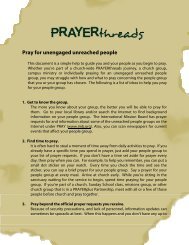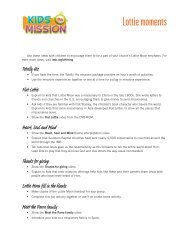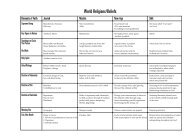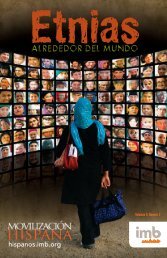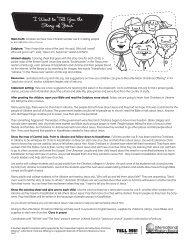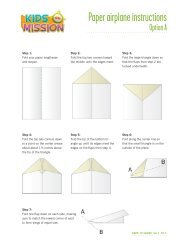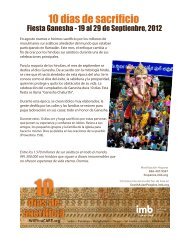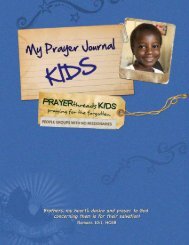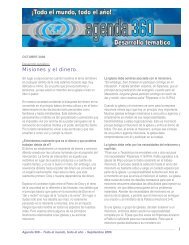THE WAYS PEOPLE LEARN By Dr. James B. Slack Exploring the ...
THE WAYS PEOPLE LEARN By Dr. James B. Slack Exploring the ...
THE WAYS PEOPLE LEARN By Dr. James B. Slack Exploring the ...
You also want an ePaper? Increase the reach of your titles
YUMPU automatically turns print PDFs into web optimized ePapers that Google loves.
The Ways People Learn--<strong>Slack</strong> 5highly literate communicator. As Walter Ong comments, many of <strong>the</strong>se highly literateindividuals do not remember and thus do not appreciate <strong>the</strong> oral roots from which <strong>the</strong>yemerged.Not only does <strong>the</strong> status of a person change as <strong>the</strong>y progress from oral communicationlevels to literate communication levels, but <strong>the</strong>ir style of communication has changeddrastically. Oral communicators — illiterates, functional illiterates and semi-literates —are not comfortable with, and cannot easily understand information that comes in <strong>the</strong>form of outlines, precepts, principles, and steps in a process. It is difficult, if notimpossible, for <strong>the</strong>m to engage in true analysis. They find it very difficult to outlineand reduce bodies of information to “bottom line” statements. Oral communicatorsprefer that information come to <strong>the</strong>m in <strong>the</strong> form of narratives or stories. They cannoteasily handle, and are definitely not comfortable with information that comes by o<strong>the</strong>rmeans. In fact, if <strong>the</strong>y have a teaching, a concept, or a principle <strong>the</strong>y want toremember, <strong>the</strong>y will clo<strong>the</strong> it in a story. Narrative styles are <strong>the</strong> common vehiclesthat oral communicators use to process and “carry around” information. Expositionalpresentations such as outlines, steps, principles, or lists of any kind are formidableobstacles for <strong>the</strong>m. They find it difficult to understand <strong>the</strong>m, and certainly cannot recall<strong>the</strong>m. They cannot use what <strong>the</strong>y cannot recall. Knowledge for oral communicators,and especially illiterates, consists only of what can be recalled.There are two important considerations. First, oral communicators — illiterates,functional illiterates, and semi-literates — can learn as well as literate persons. Theirability to learn is just as good as literates and <strong>the</strong>ir memory is superior to <strong>the</strong> averageliterate person’s memory. The problem is not that of learning but of <strong>the</strong> presentationformat through which information comes to <strong>the</strong>m. Information must come to oralcommunicators through stories, parables, poems, ballads, and similar types of formats.Format is <strong>the</strong> key for <strong>the</strong>m.Second, and conversely, most literates mistakenly believe that if <strong>the</strong>y can outline <strong>the</strong>information or put it into a series of steps or principles, anyone, including oralcommunicators, can understand it and recall it. That is a misconception concerninglearning, and how different individuals process information. Most oral communicators donot understand outlines, steps or principles, and <strong>the</strong>y certainly cannot remember <strong>the</strong>m.For that matter, nei<strong>the</strong>r can <strong>the</strong> literates, but <strong>the</strong>y store information in notes and can “lookit up” to refresh <strong>the</strong>ir memory. Illiterates cannot “look anything up,” and have nopersonal means of refreshing <strong>the</strong>ir memory if <strong>the</strong>y have forgotten something.It is very important when literate individuals prepare to communicate with o<strong>the</strong>rs that<strong>the</strong>y determine what learning category — illiterate, functional illiterate, semi-literate,literate, or highly-literate — <strong>the</strong> hearer represents before choosing <strong>the</strong> presentationformat. The Learning Grid illustrates <strong>the</strong> relationship between each learning category and<strong>the</strong> corresponding presentation format.When communicating with oral communicators — primary illiterates, functionalilliterates, or semi-literates — <strong>the</strong> story is <strong>the</strong> best “vehicle” that carries <strong>the</strong> information


